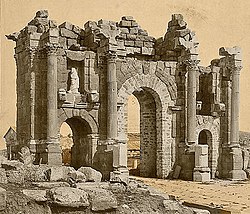Later history
The Vandal king Gaiseric, probably invited by Count Boniface, crossed from Spain to Tingis (Tangier) in 429. Some of his tens of thousands of followers besieged and conquered Rusadir around 430, while others overran the rest of northwest Africa. Focusing his attention on the Roman province of Africa, Gaiseric allowed Berber rebellions to remove most of his western territories from his control. Rusadir became part of the Berber kingdom of Altava.
The Byzantine general Belisarius restored Roman control over Northern Africa (including Rusadir) around the year 533, as part of Justinian's Vandalic War. The Exarchate of Africa established by the Byzantines also focused most of its attention on the area of present-day Tunisia and did not expand into the Mauretanian hinterland. Instead, it oversaw its fortified ports from the easily protected stronghold of Septem (Ceuta). Rusadir was conquered by the Visigoth general Suintila (probably on behalf of king Sisebuto) in 614. [16] By the early 7th century a Christian bishop with seat in the city was mentioned in the Thronus Alexandrinus. By 700, Rusadir was conquered by Musa ibn Nusayr on behalf of the Umayyad Caliphate. With an uncertain existence as populated settlement by the mid 9th century, the city was repopulated by Berbers by the late 9th century (c. 890), when it was already known by its new name, Malila/Melilla/Amlil. It was seized by an Andalusian army on behalf of Abd al-Rahman III, emir (soon-to-be Caliph) of Córdoba in 926–927. [18]
It was conquered by the Castilian nobleman Juan Alfonso Pérez de Guzmán in 1497 and—under the name Melilla (q.v.)—was formally annexed by Castile in 1506. [3]



